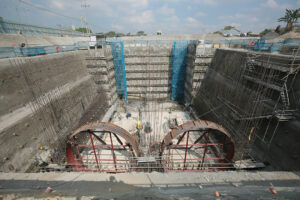By Kenneth Christiane L. Basilio, Reporter
THE DEPARTMENT of Budget and Management (DBM) proposed double-digit increases for the Education, Health and Transportation departments under the 2026 national budget, but reduced the allocation for the Public Works department by 12%.
The DBM on Wednesday submitted the P6.793-trillion National Expenditure Plan for 2026 to the House of Representatives, just over two weeks after President Ferdinand R. Marcos, Jr.’s State of the Nation Address, where he acknowledged public frustration and promised reforms in health, education and transport.
Next year’s budget is equivalent to 22% of the country’s gross domestic product (GDP), and is 7.4% higher than the P6.326-trillion national budget this year.
“The growth of our economy, the biggest contributor is government spending and infrastructure spending,” Budget Secretary Amenah F. Pangandaman told reporters after the turnover ceremonies. “Given what’s happening now, with global uncertainties, we also want to invest more in our people.”
The budget for the Education sector was increased by 16% to P1.224 trillion from P1.055 trillion this year, according to the President’s budget message.
This covers the allocation for the Department of Education (P928.5 billion, up by 18.7%), state universities and colleges (P134.9 billion, up by 6.1%), Commission on Higher Education (P33.9 billion) and Technical Education and Skills Development Authority (P20.2 billion).
“For the first time, the budget for basic and higher education has been increased monumentally to meet UNESCO’s (United Nations Educational, Scientific and Cultural Organization) recommended education spending target of at least 4% of the country’s GDP,” said Ms. Pangandaman.
National Government spending on education for next year would also meet the UNESCO-recommended 15-20% of total public expenditure.
“This is because we are determined to deliver immediate action on child nutrition, address the education crisis and support our youth so they can find jobs,” Ms. Pangandaman said. “If you have a young person who can read, who can study and is healthy, they will contribute to our workforce.”
INFRASTRUCTURENext year’s budget for the infrastructure program stood at P1.556 trillion, equivalent to 5% of the Philippine GDP, according to the budget document.
“We are fast-tracking infrastructure development to create more livable communities, modernize transportation systems and address long-standing challenges,” the DBM said in the budget document.
The Department of Public Works and Highways (DPWH) was allocated P881.3 billion, 12% lower than this year’s P1.007-trillion budget.
“There are still many ongoing (DPWH) projects,” Ms. Pangandaman said in Filipino. “If you peg it at the same level (as last year), their absorptive capacity, they might struggle.”
On the other hand, the Department of Transportation’s proposed 2026 budget was more than doubled to P197.3 billion from P87.2 billion this year.
The government is prioritizing 54 flagship projects next year such as the Bataan-Cavite Interlink Bridge (P27.9 billion), Laguna Lakeshore Road Network (P22.9 billion) and the fourth phase of the Pasig-Marikina River Channel Improvement Program (P7.4 billion).
The government also earmarked P124.1 billion for rail transport upgrades, including P76.1 billion for the North-South Commuter Railway System and P45.4 billion for the first phase of the Metro Manila Subway Project.
Around P69.7 billion will go to so-called Sustainable Infrastructure Projects Alleviating Gaps programs that involve the construction of roads, bridges and flood control projects.
The Department of Health was earmarked P320.5 billion under next year’s budget, up by 29% from this year’s P248 billion.
State hospitals in Metro Manila were allotted P27.7 billion, while regional hospitals will receive P99.5 billion to boost healthcare capacity.
The Defense department and its attached agencies, such as the Philippine military, was allotted a P299.3-billion budget, up by 10.3% from P271 billion for this year amid growing tensions with China in the disputed South China Sea.
The Philippine Army, Air Force and Navy will collectively receive P260.6 billion under the proposed budget, while P40 billion will go to the Armed Forces’ modernization efforts, based on the budget document.
The government is proposing a P256.5-billion budget for the agriculture sector next year, 81% higher than this year’s P141.7 billion.
Of this amount, P153.9 billion will go to the Department of Agriculture (DA) and its attached agencies, P45.1 billion for the National Irrigation Administration and P17.4 billion for the Department of Agrarian Reform.
The budget for the DA’s National Rice Program went up by 37.8% to P29.9 billion for next year, while the Rice Competitiveness Enhancement Fund will receive P30 billion.
About P10 billion will go towards funding the Marcos administration’s Rice for All Program to help expand access to cheaper rice, with P11.2 billion allotted for the government’s rice buffer stocking initiative.
NO ‘AKAP’ FUNDSNext year’s funding for the Department of Social Welfare and Development stood at P223.4 billion, which is 2.7% higher than the P217-billion budget in 2025. The bulk or P113 billion will go to the Pantawid Pamilyang Pilipino Program, while P49.8 billion will go to social pension for indigent senior citizens.
The government did not allot funds for the Ayuda Para sa Kapos ang Kita Program (AKAP) for this year, Ms. Pangandaman said.
AKAP is a social welfare scheme that provides one-time cash assistance worth P3,000 to P5,000 to workers whose income falls below the poverty threshold. It drew criticism last year after concerns that its disbursement could be politicized by lawmakers.
Meanwhile, the government has allotted P10.77 billion for confidential and intelligence funds (CIF), 11% lower than the P12.1-billion budget this year.
Ms. Pangandaman said the Office of the President was allocated P4.5 billion in secret funds, with the Defense department receiving P1.9 billion under the proposed budget. The remaining funds would go to other agencies, like the National Intelligence Coordinating Agency and Anti-Money Laundering Council.
CIFs are meant to finance surveillance and intelligence information gathering activities, according to a 2015 joint circular between the Commission on Audit, Defense, Budget and Interior and Local Government departments.
On the other hand, the government plans to allocate nearly P1 trillion in 2026 for debt servicing, taking up 14.4% of the proposed budget for next year. This is 12% higher than the P876.73 billion allotted this year.
‘LIMITED FISCAL SPACE’“While (next year’s budget) is 7.4% higher than this year’s P6.326-trillion national budget, the economic team carefully considered the available fiscal space and worked diligently to tighten the budget,” Ms. Pangandaman said.
The government slashed agency budget proposals by 33% to P6.793 trillion for 2026 from an initial P10 trillion, by prioritizing expenditures that could support economic growth, she added.
“Given our limited fiscal space, we carefully evaluated all submissions,” said Ms. Pangandaman.
The government is targeting 5.5-6.5% GDP growth this year, and 6-7% growth from 2026 to 2028. It also aims to bring down the debt-to-GDP ratio to 60.4% by the end of 2025, and to 56.9% by 2028.
Nueva Ecija Rep. Mikaela Angela B. Suansing, who heads the House Appropriations Committee, said budget discussions will start on Aug. 18, giving congressmen nearly two months to scrutinize and approve the budget bill before submitting it to the Senate.
“From Aug. 18 to Oct. 10, we will carefully examine the budget,” she told reporters in Filipino. “We will ensure that deliberations for next year’s budget are thorough.”


















